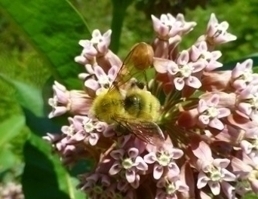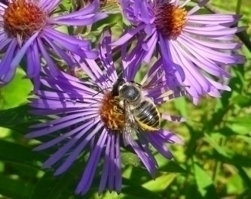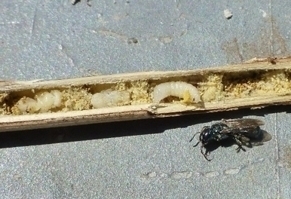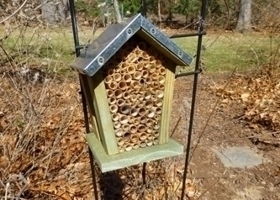
Bombus fervidus on common milkweed.

Megachile bee on aster.
Things to Consider
Before deciding what plants to include in a pollinator garden, consider which bees or other pollinators are already living in or visiting the area already, and then think about the pollinators that you may want to attract. Not all plants, sites and soils may be suitable for all bees, especially those that require specific nesting sites or materials plus seasonal bloom times.
Plant for the longest bloom periods having flowers available from early spring through fall. Native and non-native plants that will provide nectar and pollen at different times of the year should be incorporated to ensure the greatest number of species can find food, both for themselves and for their offspring. Native plants have bloom periods that coincide with the seasonal periods of activity of the different species of native bees, so including native trees, shrubs and perennials will complement non-native plants.
Many native bees nest in the ground, in holes bored in wood or inside pithy plant stems. Leaving small areas of bare soil in the lawn, along wood lines or near the bases of shrubs will help certain ground nesting bees to find a suitable place to create underground nests for egg laying.
See if a few weeds can be tolerated in lawns, especially weeds that flower early- dandelions, dead nettle, ground ivy and violets. Both native and honey bees use these plants as food sources.
Insecticides and some other pesticides may be toxic to bees. If you must use a pesticide, apply at night, if possible, Avoid broad-spectrum insecticides on plants in flower. Never spray flowers. Choose products that are not harmful to bees.
Tips on Choosing Flowering Plants for New England
Choose plants that flower in early spring for bumblebee queens, honey bees and native bees that are out very early in the year. Native willows, dandelions, ground ivy and dead nettle are important nectar and pollen sources for many bees. Also, red maples bloom very early and although wind pollinated, many bees will still use their flowers as food sources. For late fall, witch hazels may bloom from October through late November and are a source of food for bees that are still active in the colder weather.
Plant in drifts, using three or more plants of the same genus in a small group, rather than just using one type of plant but in several spots. An example would be to plant three purple coneflowers together rather than using three coneflowers but separately in the garden. Bees will find easier access to favorite flowers when they are located near each other.
Shrubs and Trees for Attracting Bees
| Common name | Latin Name | Bloom time |
| Azalea | Rhododendron | Spring |
| Basswood, Linden | Tilia americana | Summer |
| Blackhaw, Viburnum | Viburnum | Summer |
| Blueberry | Vaccinium | Spring |
| Butterfly bush | Buddleia | Summer |
| Catalpa | Catalpa | Spring |
| Cherry (native, ornamental) | Prunus | Spring |
| Chokeberry | Aronia | Spring |
| Crabapple | Malus | Spring |
| Currant | Ribes | Spring |
| Dogwoods | Cornus | Spring |
| Dogwoods (shrub) | Cornus | Summer |
| Elderberry | Sambucus | Spring |
| Fothergilla | Fothergilla | Spring |
| Hawthorn | Crataegus | Spring |
| Honeysuckle (native) | Lonicera | Spring |
| Hydrangea (tree) | Hydrangea paniculatum | Summer |
| Ninebark | Physocarpus | Summer |
| Red maple | Acer rubrum | Spring |
| Redbud | Cercis | Spring |
| Rhododendron | Rhododendron | Summer |
| Rose-of-Sharon | Hibiscus | Summer |
| Shadbush | Amalanchier | Spring |
| Virginia sweetspire | Itea virginica | Summer |
| Willow (native) | Salix | Spring |
| Winterberry | Ilex verticillata | Spring |
| Witch-hazel (native) | Hamamelis | Fall |
Annuals and Perennials for Attracting Bees
| Common name | Latin Name | Bloom time | Annual/Perennial |
| Allium | Allium | Spring/Summer | Perennial |
| Alyssum | Alyssum | Summer | Annual |
| Anise hyssop | Agastache foeniculum | Summer | Perennial |
| Aster | Aster | Fall | Perennial |
| Black-eyed Susan | Rudbeckia | Summer | Perennial |
| Blazing star | Liatris | Summer | Perennial |
| Bluebeard | Caryopteris | Summer | Perennial |
| Bloodroot | Sanguinaria | Spring | Perennial |
| Boneset | Eupatorium perfoliatum | Summer/Fall | Perennial |
| Borage | Borago | Summer | Annual |
| Bugbane | Cimicifuga | Fall | Perennial |
| Clover | Trifolium | Spring/Summer | Annual |
| Comfrey | Symphytum | Summer | Perennial |
| Coneflower | Echinacea purpura | Summer | Perennial |
| Cosmos | Cosmos | Summer | Perennial |
| Dandelion | Taraxacum | Summer | Perennial |
| Goldenrod | Solidago | Summer | Perennial |
| Herbs (assorted) | Summer | Perennial | |
| Heliotrope | Heliotropium | Summer | Annual |
| Joe-pye weed | Eupatorium | Summer | Perennial |
| Lantana | Lantana | Summer | Annual |
| Maximilian sunflower | Helianthus | Fall | Annual |
| Mexican sunflower | Tithonia | Summer/Fall | Annual |
| Milkweeds | Asclepias | Summer | Perennial |
| Mints | Mentha | Summer | Perennial |
| Montauk daisy | Nipponanthemum | Fall | Perennial |
| Mountain mints | Pycnanthemum | Summer | Perennial |
| Obedient plant | Physostegia | Summer | Perennial |
| Peppers | Capsicum | Summer | Perennial |
| Raspberries | Rubus | Spring/Summer | Perennial |
| Russian sage | Perovskia | Summer | Perennial |
| Salvia | Salvia | Summer | Perennial |
| Sedum/Stonecrop | Sedum | Summer | Perennial |
| Snakeroot | Actaea | Fall | Perennial |
| Spurge | Euphorbia | Summer | Annual |
| Sunflowers | Helianthus | Summer | Annual |
| Verbena | Verbena | Summer | Annual |
| Veronica | Veronica | Summer | Perennial |
| Violets | Viola | Spring | Perennial |
| Zinnia | Zinnia | Summer | Annual |
Additional information on pollinator plants suitable for the Northeast:
USDA: Pollinator Friendly Plants for the Northeast United States
Pollinator Plants: Northeast Region
Trees and Shrubs Suggested Native Species for Pollinators
Leave small areas of bare ground for ground-nesting bees, especially where soils are sandy. Do not mulch directly up the base of shrubs as some bees, like Andrena ssp., make nesting chambers in the ground under shrubs and they need access to some exposed soil. Provide a water source- a shallow dish with pebbles is a good choice, or a birdbath with a stone for bees to keep dry while sipping water.
Do not prune any plants with pithy or hollow stems until spring. These stems are used by some bees for nesting sites. Adults will emerge the following spring. If pruning is necessary, then tie stems together and hang from a branch until the following spring rather than composting or discarding them. If nesting boxes are used, place them far away from each other to discourage parasitic insects from finding larvae.

Ceratina sp. nesting chamber in shrub Hydrangea stem. Nesting house for bees using bamboo tubes that are sealed at one end.

Nesting house for bees using bamboo tubes that are sealed at one
Despite good cultural practices, pests and diseases at times may appear. Chemical control should be used only after all other methods have failed.
For pesticide information or other questions please call toll free: 877-486-6271.
UConn Home and Garden Education Center, 2019